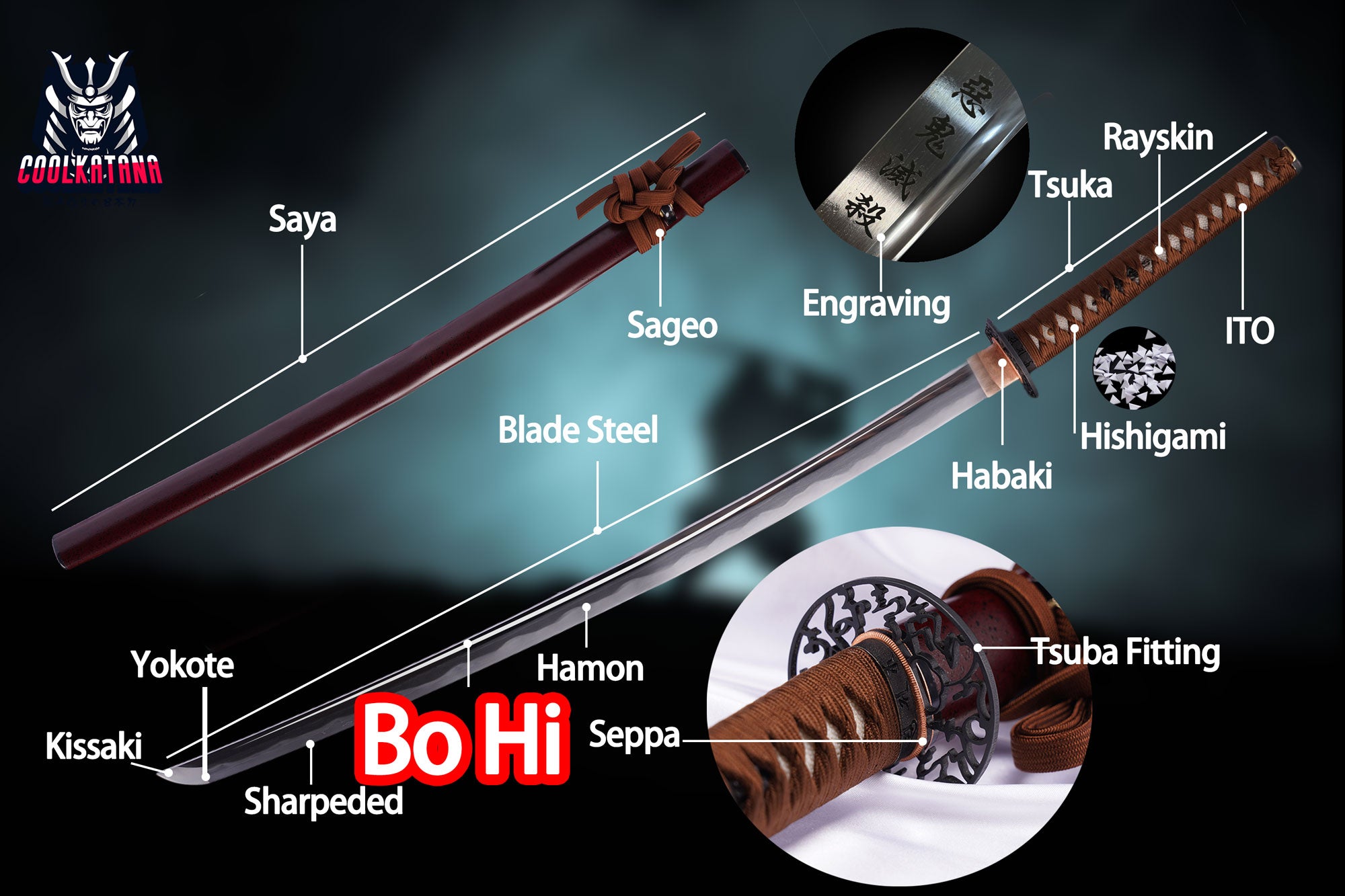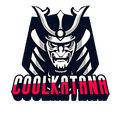Analysis of Katana Bo-Hi Types: Features and Benefits Explained

what is bo-hi on a katana?
In the design of a katana, Bo-Hi (棒樋) is a crucial element. It refers to a groove or channel along the blade, typically running vertically along the length of the sword. Bo-Hi not only significantly impacts the appearance of the katana but also serves multiple functions, primarily reducing the weight of the blade, enhancing its flexibility, improving cutting performance, and adding a visual aesthetic to the blade. Depending on the intended use and the craftsman's design choices, there are various types of Bo-Hi, each with its unique advantages in performance and aesthetics.
Here, we will explore several common types of Bo-Hi, including Standard Bo-Hi, Tome Standard Bo-Hi, Shinken Bo-Hi, Tome Bo-Hi, Double Hi, Soe Hi, Standard Naginata Hi, Geometric Naginata Hi, and Soe Naginata Hi, analyzing their characteristics, advantages, and applicable scenarios.
1. Standard Bo-Hi (Standard Bo-Hi)
The Standard Bo-Hi is the most common design, typically extending along the entire length or a large portion of the katana. This design is simple and practical, effectively reducing the weight of the blade and enhancing its maneuverability.
Characteristics and Advantages of Standard Bo-Hi:
- Reduces Weight: The groove decreases the overall weight of the blade, making the katana more flexible and easier to handle.
- Enhances Cutting Performance: The Bo-Hi improves the blade's aerodynamics, reducing air resistance during fast swings and improving cutting efficiency.
- Visual Appeal: The simple design of Standard Bo-Hi is often seen in traditional katana, offering a classic aesthetic value.
Applicable Scenarios: Suitable for traditional katana, balancing aesthetics and functionality, ideal for enthusiasts who appreciate classic styles.

2. Tome Standard Bo-Hi (Tome Standard Bo-Hi)
Tome Standard Bo-Hi is similar to the Standard Bo-Hi but has a more simplified groove design, typically not extending to the end of the blade, adding a cleaner look to the weapon.
Characteristics and Advantages of Tome Standard Bo-Hi:
- Simplified Design: The groove design is shorter, giving the blade a sleeker, more modern appearance.
- Reduces Unnecessary Weight: This type of Bo-Hi effectively reduces the blade’s weight, improving maneuverability.
- Suitable for Combat Blades: Due to its minimalistic design, Tome Standard Bo-Hi is commonly found on swords meant for practical use in combat.
Applicable Scenarios: Ideal for combat katana, particularly for users who need high-performance blades for modern weapons or fighting situations.

3. Shinken Bo-Hi
Shinken Bo-Hi is a type of Bo-Hi designed specifically for combat, often running through the center of the blade. "Shinken" means "real sword," and this design focuses on increasing the blade's durability and strength.
Characteristics and Advantages of Shinken Bo-Hi:
- Increases Blade Strength: Proper Bo-Hi design can enhance the blade’s structural integrity, making it less likely to bend or break under high stress.
- Improves Combat Performance: The design provides better stability during cutting, making it suitable for high-frequency and high-stress combat use.
- Expert Craftsmanship: Shinken Bo-Hi typically involves more complex craftsmanship, showcasing the smith's skill.
Applicable Scenarios: Suitable for professional combat blades, especially those intended for use in high-pressure environments.

4. Tome Bo-Hi
Tome Bo-Hi is similar to Tome Standard Bo-Hi, but the groove is deeper and extends further, creating a more pronounced visual effect.
Characteristics and Advantages of Tome Bo-Hi:
- Increases Blade Strength: Deeper grooves enhance the overall strength of the blade, making it more durable in combat.
- Striking Visual Effect: The design is more visually striking, appealing to those who value aesthetic beauty.
- Improves Cutting Performance: With an optimized aerodynamic design, it reduces resistance during cutting, increasing speed.
Applicable Scenarios: Ideal for those seeking a balance between aesthetic beauty and combat performance in their katana.

5. Double Hi (Double Hi)
The Double Hi design refers to two parallel grooves on either side of the blade. This design balances the blade's structure, offering increased resistance to bending and improving stability.
Characteristics and Advantages of Double Hi:
- Improves Blade Balance: Two grooves provide better structural balance, which increases the sword’s stability.
- Enhances Resistance to Bending: The Double Hi design helps prevent the blade from bending, adding to the sword’s durability.
- Visual Impact: The design offers a unique, eye-catching appearance, enhancing the blade’s artistic value.
Applicable Scenarios: Ideal for those who seek both performance and distinctive visual appeal in their katana.

6. Soe Hi (Soe Hi)
Soe Hi is a special type of Bo-Hi where the grooves run from the top of the blade down to the bottom, slanting to meet the centerline of the blade. This design enhances the stability and cutting ability of the katana.
Characteristics and Advantages of Soe Hi:
- Enhances Blade Stability: The unique groove design increases stability during cutting, reducing blade vibration.
- Increases Blade Strength: This design also enhances the overall strength of the blade, making it less likely to deform during heavy use.
Applicable Scenarios: Ideal for swords where blade performance and stability are prioritized.

7. Standard Naginata Hi (Standard Naginata Hi)
The Standard Naginata Hi design is used for traditional naginata blades, generally aimed at reducing the overall weight of the blade and enhancing the weapon’s flexibility.
Characteristics and Advantages of Standard Naginata Hi:
- Improves Flexibility: The design lightens the naginata, making it more maneuverable and agile.
- Enhances Cutting Performance: Reducing the weight helps increase the speed and precision of cuts.
Applicable Scenarios: Primarily used for traditional naginata, appealing to weapon enthusiasts and collectors.

8. Geometric Naginata Hi (Geometric Naginata Hi)
The Geometric Naginata Hi features grooves in geometric shapes, designed to enhance the cutting power and stability of the naginata while offering a unique aesthetic.
Characteristics and Advantages of Geometric Naginata Hi:
- Improves Cutting Performance: The geometric groove design enhances aerodynamics, stabilizing the blade and improving cutting efficiency.
- Unique Aesthetic: The geometric shapes provide a modern look, making the blade visually appealing.
Applicable Scenarios: Suitable for high-end naginata, catering to weapon enthusiasts and collectors.

9. Soe Naginata Hi (Soe Naginata Hi)
Soe Naginata Hi is a type of groove design with a slanted channel, enhancing the balance and stability of the naginata during use.
Characteristics and Advantages of Soe Naginata Hi:
- Improves Blade Stability: The slanted groove increases stability and shock resistance.
- Enhances Cutting Performance: This design ensures better stability and efficient cutting, even in complex environments.
Applicable Scenarios: Ideal for professional naginata requiring high stability and cutting performance.

www.coolkatana.com
Summary
The Bo-Hi design of a katana is not just a part of its appearance but plays a critical role in the blade’s performance. Different types of Bo-Hi offer various advantages, improving the flexibility, cutting ability, stability, and aesthetics of the sword. By reducing weight, optimizing aerodynamics, and enhancing the blade's structural integrity, Bo-Hi designs help achieve an excellent balance between performance and visual appeal, catering to a wide range of enthusiasts and professional needs.

